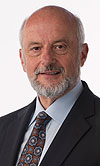Update on tritium management at Fermilab
 |
Fermilab Director
Pier Oddone |
Next year, with the restart of our accelerator complex, Fermilab is poised to enter a new era of experiments with high-intensity particle beams. To prepare for this new era, we are upgrading and improving the accelerator complex and building new particle detectors. But with higher-intensity beams will also come an increase in the production of tritium, and we are preparing for that as well.
Tritium, a weakly radioactive isotope of hydrogen, is a normal byproduct of accelerator operations here at Fermilab. Very small but detectable levels of tritium are found in some of the ponds on our site, in Indian Creek, which flows to a pond in the Savannah community off site, and in sanitary sewer water that is pumped to a wastewater treatment facility in Batavia. These levels are well below regulatory standards that Fermilab is required to meet.
But we are not satisfied with merely meeting those standards. We are dedicated to keeping the amounts of tritium produced and discharged from the site as low as possible. Since 2005, when low levels of tritium were first detected in Indian Creek, we have put in place many measures to minimize the amounts of tritium in ponds and creeks. The lab's Tritium Working Group is now focused on reducing the levels of tritium present in sanitary sewer water.
We are also renewing our commitment to keeping employees and the public fully informed about tritium on the Fermilab site. In 2005, we launched a website that provides information about tritium in surface water, and we have regularly updated it with results from water samples taken from the three creeks on site. Recent water samples taken from Indian Creek show levels of 4 picocuries per milliliter (pCi/mL), well below the regulatory standard of 1,900 pCi/mL for surface water.
The website now also includes the results of water samples taken from the sanitary sewer water that is pumped to Batavia's wastewater treatment facility. The highest level of tritium found to date in this sanitary sewer water is about 8 pCi/mL, far below the regulatory standard of 9,500 pCi/mL that Fermilab is required to meet. Information is also available online about the emission of water containing low levels of tritium into the air and the disposal of tritium as solid waste.
Though the levels of tritium discharged by Fermilab pose no health risk to our employees, visitors or neighbors, we take the matter very seriously. In addition to our continuing efforts to minimize the amounts of tritium produced and discharged from our site, we will keep our employees, the Community Advisory Board and the public informed as new readings and new steps are taken.
If you have questions about tritium at Fermilab, please contact the Fermilab Office of Communication at 630-840-3351 or send an email to fermilab@fnal.gov.
|